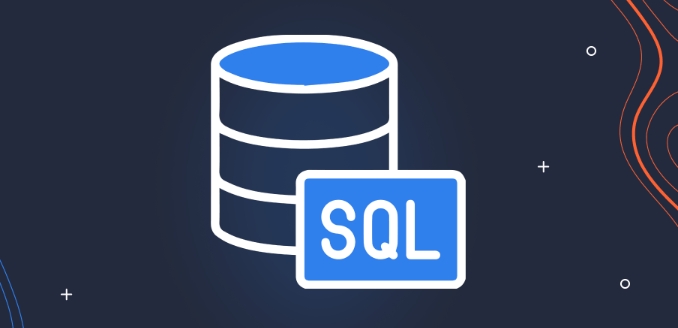Using indexes can speed up SQL queries. Indexes create a mapping structure from column values to physical locations, so that the database can quickly locate data without scanning the entire table. For example, when querying through mailboxes in a million row user table, there is an index that can directly jump to the target row. Indexes should be used for columns that appear frequently in WHERE, JOIN, or ORDER BY clauses, but avoid overuse to avoid affecting write performance. Secondly, indexing can significantly improve the efficiency of multi-table connections, especially common connection operations in normalized databases. It is recommended to index columns as foreign keys. In addition, using indexes reasonably can avoid full table scanning, but it should be noted that the database may ignore indexes due to excessive data matching. You can check the index usage through the EXPLAIN command. Finally, not all scenarios are suitable for indexing, such as small tables or low-unique columns (such as gender) usually do not require indexing, but in most large applications, reasonable indexing is crucial for performance optimization.

Using an index in SQL is like adding a table of contents to a book—it helps the database find data faster without scanning the whole table. If you're querying a large dataset and doing it without indexes, you're basically asking the database to read everything just to find a small piece of what you need. That's slow and inefficient.

Here's why indexes matter and how they help:
Speed up data retrieval
The main reason to use an index is to make queries faster. When you create an index on a column (like user_id or email ), the database creates a separate structure that maps the values in that column to their physical location in the table. This makes looking up specific values much quicker.

For example, imagine you have a users table with a million rows and you're searching for a user by email:
SELECT * FROM users WHERE email = 'test@example.com';
Without an index, the database has to scan every row to find that email. With an index on the email column, it can jump straight to the matching row(s).

- Use indexes on columns that are frequently used in
WHERE,JOIN, orORDER BYclauses. - Be careful not to overdo it—indexes take up space and can slow down write operations like
INSERT,UPDATE, andDELETE.
Improve performance on joins
When you're joining two or more tables, especially large ones, having indexes on the join columns can make a big difference. For example, if you're joining orders and customers on customer_id , an index on orders.customer_id and customers.id will help the database find matching rows faster.
This is especially important in normalized databases where joins are common.
- Always consider indexing foreign key columns since they're often used for joining.
- If your joins are slow and you haven't indexed the relevant columns, that's a good place to start optimizing.
Avoid full table scans
A full table scan is when the database reads every row in a table to find what it needs. This is unavoidable if there's no index to help, but it's a performance killer—especially as your data grows.
By creating the right indexes, you avoid scanning the entire table and instead go straight to the data you need.
Some things to keep in mind:
- The database might ignore an index if it thinks scanning the whole table is faster (eg, when most rows match the condition).
- Use
EXPLAINorEXPLAIN ANALYZEto see whether your queries are using indexes or falling back to full scans.
There are definitely cases where indexes aren't needed or even hurt performance, like on small tables or columns with very few unique values (like a gender column). But for most real-world applications with large datasets and frequent queries, using indexes wisely can make a big difference.
Basically that's it.
The above is the detailed content of Why use an index in SQL?. For more information, please follow other related articles on the PHP Chinese website!

Hot AI Tools

Undress AI Tool
Undress images for free

Undresser.AI Undress
AI-powered app for creating realistic nude photos

AI Clothes Remover
Online AI tool for removing clothes from photos.

Clothoff.io
AI clothes remover

Video Face Swap
Swap faces in any video effortlessly with our completely free AI face swap tool!

Hot Article

Hot Tools

Notepad++7.3.1
Easy-to-use and free code editor

SublimeText3 Chinese version
Chinese version, very easy to use

Zend Studio 13.0.1
Powerful PHP integrated development environment

Dreamweaver CS6
Visual web development tools

SublimeText3 Mac version
God-level code editing software (SublimeText3)
 SQL: The Language, MySQL: The Database Management System
Apr 21, 2025 am 12:05 AM
SQL: The Language, MySQL: The Database Management System
Apr 21, 2025 am 12:05 AM
The relationship between SQL and MySQL is: SQL is a language used to manage and operate databases, while MySQL is a database management system that supports SQL. 1.SQL allows CRUD operations and advanced queries of data. 2.MySQL provides indexing, transactions and locking mechanisms to improve performance and security. 3. Optimizing MySQL performance requires attention to query optimization, database design and monitoring and maintenance.
 MySQL: A Practical Application of SQL
May 08, 2025 am 12:12 AM
MySQL: A Practical Application of SQL
May 08, 2025 am 12:12 AM
MySQL is popular because of its excellent performance and ease of use and maintenance. 1. Create database and tables: Use the CREATEDATABASE and CREATETABLE commands. 2. Insert and query data: operate data through INSERTINTO and SELECT statements. 3. Optimize query: Use indexes and EXPLAIN statements to improve performance.
 SQL vs. MySQL: Clarifying the Relationship Between the Two
Apr 24, 2025 am 12:02 AM
SQL vs. MySQL: Clarifying the Relationship Between the Two
Apr 24, 2025 am 12:02 AM
SQL is a standard language for managing relational databases, while MySQL is a database management system that uses SQL. SQL defines ways to interact with a database, including CRUD operations, while MySQL implements the SQL standard and provides additional features such as stored procedures and triggers.
 Comparing SQL and MySQL: Syntax and Features
May 07, 2025 am 12:11 AM
Comparing SQL and MySQL: Syntax and Features
May 07, 2025 am 12:11 AM
The difference and connection between SQL and MySQL are as follows: 1.SQL is a standard language used to manage relational databases, and MySQL is a database management system based on SQL. 2.SQL provides basic CRUD operations, and MySQL adds stored procedures, triggers and other functions on this basis. 3. SQL syntax standardization, MySQL has been improved in some places, such as LIMIT used to limit the number of returned rows. 4. In the usage example, the query syntax of SQL and MySQL is slightly different, and the JOIN and GROUPBY of MySQL are more intuitive. 5. Common errors include syntax errors and performance issues. MySQL's EXPLAIN command can be used for debugging and optimizing queries.
 SQL in Action: Real-World Examples and Use Cases
Apr 18, 2025 am 12:13 AM
SQL in Action: Real-World Examples and Use Cases
Apr 18, 2025 am 12:13 AM
In practical applications, SQL is mainly used for data query and analysis, data integration and reporting, data cleaning and preprocessing, advanced usage and optimization, as well as handling complex queries and avoiding common errors. 1) Data query and analysis can be used to find the most sales product; 2) Data integration and reporting generate customer purchase reports through JOIN operations; 3) Data cleaning and preprocessing can delete abnormal age records; 4) Advanced usage and optimization include using window functions and creating indexes; 5) CTE and JOIN can be used to handle complex queries to avoid common errors such as SQL injection.
 Getting Started with SQL: Essential Concepts and Skills
Apr 22, 2025 am 12:01 AM
Getting Started with SQL: Essential Concepts and Skills
Apr 22, 2025 am 12:01 AM
SQL is a language used to manage and operate relational databases. 1. Create a table: Use CREATETABLE statements, such as CREATETABLEusers(idINTPRIMARYKEY, nameVARCHAR(100), emailVARCHAR(100)); 2. Insert, update, and delete data: Use INSERTINTO, UPDATE, DELETE statements, such as INSERTINTOusers(id, name, email)VALUES(1,'JohnDoe','john@example.com'); 3. Query data: Use SELECT statements, such as SELEC
 Where to start writing SQL code? How to start writing SQL code? Guide to starting point of writing SQL code?
Jun 04, 2025 pm 07:27 PM
Where to start writing SQL code? How to start writing SQL code? Guide to starting point of writing SQL code?
Jun 04, 2025 pm 07:27 PM
The starting point of writing SQL code is to clarify the requirements. 1) Understand the problem you want to solve and determine the relationship between the required data and tables. 2) Start designing queries from simple SELECT statements and gradually increase complexity. 3) Use visualization tools to understand table structure and consider using JOIN when queries are complex. 4) Test the query and use the EXPLAIN command to optimize performance to avoid common pitfalls such as NULL value processing and inappropriate index use.
 SQL's Versatility: From Simple Queries to Complex Operations
May 05, 2025 am 12:03 AM
SQL's Versatility: From Simple Queries to Complex Operations
May 05, 2025 am 12:03 AM
The diversity and power of SQL make it a powerful tool for data processing. 1. The basic usage of SQL includes data query, insertion, update and deletion. 2. Advanced usage covers multi-table joins, subqueries, and window functions. 3. Common errors include syntax, logic and performance issues, which can be debugged by gradually simplifying queries and using EXPLAIN commands. 4. Performance optimization tips include using indexes, avoiding SELECT* and optimizing JOIN operations.






